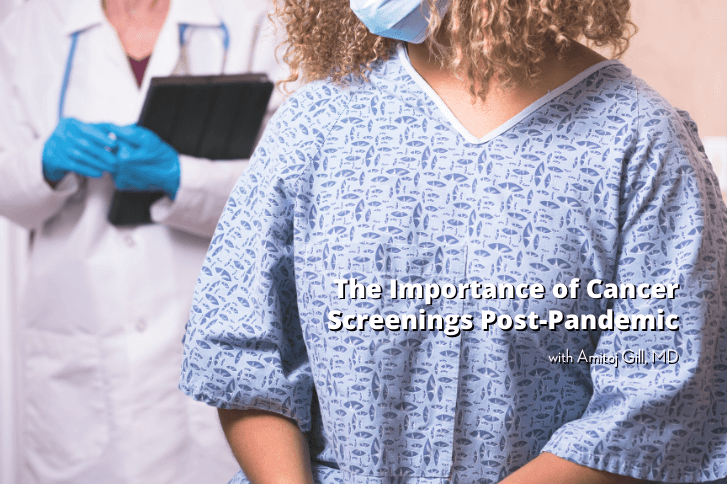The Importance of Cancer Screenings Post-Pandemic

Apple Podcasts Google Play iHeartRadio Tunein Spotify Amazon
In this episode of Baptist Health’s Health Talks NOW podcast, hosts Kerri and Kendra are finally back in the studio and are kicking things off with an important episode. Adding to the list of things disrupted by the COVID-19 pandemic, many elective medical procedures, including cancer screenings, were primarily put on hold. Alongside today’s guest Amitoj Gill, MD, they will discuss and further understand the possible repercussions.
As the number of patients being screened for cancer declined, experts also noted a steep drop in cancer diagnoses. Studies are now being conducted on how the decrease in cancer screenings may affect healthcare in the future. It’s kind of a wait-and-see. Knowing this, the hosts ask Dr. Gill what patients can do now. Most importantly, patients should get vaccinated to prevent serious possible infection. Second, they should speak with their primary physicians if they have and seek medical attention if any symptoms occur and get back to having age-appropriate cancer screenings.
Then, Dr. Gill points out some of the repercussions of delaying cancer screenings and shares his observations on why people put them off. More patients with advanced, harder-to-treat cancers are being diagnosed now. When detected earlier, chances for cure are greater. More recently, the cause for delaying cancer screenings has been the pandemic with many afraid of contracting the virus. Another reason for delaying screening is fear and denial of the potential diagnosis. Dr. Gill wants to reassure patients that being diagnosed at earlier stages is actually a good thing rather than waiting and allowing it to spread.
What are the key differences in prognosis of cancers that are diagnosed in early stages vs. later on? First, there is a greater chance for curing cancers diagnosed during stages 1-3. Once cancer spreads to other organs, it becomes stage 4, where a cure is very unlikely. It’s almost impossible to say how quickly cancer spreads as it is dependent on a multitude of factors, such as the type of cancer. It can take anywhere between months to several years for cancer to go from stage 1 to stage 4. The separate stages are determined by how widespread the cancer is throughout the body and the prognosis. If the cancer is limited to the organ of origin, for example, the lung, it is classified as stage 1 or 2. If it spreads to the lymph nodes it is considered stage 3. Then, if it spreads to other organs via the bloodstream, it becomes stage 4. It’s very technical with lots of variations and is updated regularly, usually every other year.
There are three methods for cancer to spread. The first is local invasion, which is when the cancer grows and spreads locally, invading adjacent organs. The second method is lymphatic spread, when the lymph nodes drain into the venous system, dumping into the blood. The third method is directly through the bloodstream, driving the cancer stream all throughout the body and depositing it in different organs. It is extremely rare to have cancer of the heart because it’s such a powerhouse of an organ.
In terms of what can be done, it is usually sufficient to catch cancer at an early stage during a routine screening. The USPSTF bases its guidelines on studies that have been done. Based on these studies, it is clear that earlier detection saves lives. Conducting CAT scans and screenings as often as every year will actually cause more harm than good, exposing you to more radiation in the long run. In the future, there will be new studies and methods for checking cancers. For now, however, screenings are as efficient as they can possibly be. It’s important to note that there are behavioral prevention methods that should be considered as well. These include limiting alcohol intake, maintaining a healthy weight, not smoking, and exercising regularly reduces your risk for cancer and other diseases.
Dr. Gill walks us through some of the more common screening procedures and what they entail for healthy individuals following the USPSTF guidelines. Breast cancer mammogram screening is recommended for women aged 50-74 every other year. The discussion should begin with her primary physician at age 40 and, if predisposed by genetics, the screenings should begin at an earlier age. Cervical cancer pap smear screening is recommended every 3 years in women aged 21-29. For women aged 30-65, screening is recommended every 3 years with pap smear alone or every 5 years with the pap smear and HPV DNA test. The guidelines for colorectal cancer have been recently updated, recommending screening beginning at 45. For lung cancer, USPSTF recommends that patients who currently smoke or have quit within the past 15 years in the age group of 50-80 should get a low-dose CT of the chest every year.
There are some types of cancers that don’t have a particular screening process, raising even more anxiety. In those instances, you’re looking for any changes of symptoms or bodily functions. Currently, there is no method for universal screening. Dr. Gill believes it important to note that if patients notice concerning signs, they should notify their physician as soon as possible. Every cancer has its own signs and symptoms and it is important to stay up to date on routine exams and physicals.
There is a noticeable difference in mindset in millennials and younger generations when it comes to primary care. Our parents and grandparents knew their primary care physician by name and were dedicated to building a relationship with them. Evidence shows that now, younger people not only don’t have a dedicated primary care physician but also don’t seek primary care in general. More people are beginning to utilize urgent care as primary care and overlooking annual physicals and checkups. It’s so important to get established early on with a dedicated primary care physician who can get to know you and your history to work together towards identifying any changes during a yearly checkup.
Currently, the most common cancers in the U.S. are breast, lung, prostate, colorectal and melanoma. By 2040, melanoma will likely be considered the second most common cancer type. These projections are based on studies and incidents of how these have changed over the course of the last several decades. The projections could or could not be true. The projection of melanoma becoming more common is based on the rise in diagnoses of skin findings with primary physician visits. There is also the factor of climate change and increased exposure to ultraviolet light.
Prostate cancer is predicted to drop a ranking. This is likely because screenings have dropped in light of a USPSTF recommendation, and will probably continue to do so. However, more recently this recommendation has been updated, urging the patient and physician to determine the importance of such tests and screenings. These projections can be compared to the work of a meteorologist, looking at models and trends to say, perhaps, “There is a 40% chance it could rain on Thursday.”
Cancer is a field that experts are continuing to rapidly learn about with so much left to discover. At this point, we all know somebody who has been impacted by cancer, making awareness so critical. Before bringing the episode to an end, Kerri and Kendra offer closing thoughts, focusing on takeaways for listeners. The most important thing is not to delay seeking medical attention, including age-appropriate cancer screenings and annual physicals.
Key Takeaways:
Episode Links:
Get in touch with Dr Amitoj Gill.
Learn more about Baptist Health and opportunities for virtual care.
Sign up for MyChart, Baptist Health’s free patient portal.
To get in touch, email [email protected].
Follow Baptist Health:



